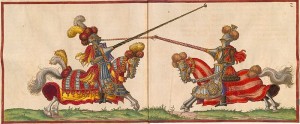 The shrovetide joust of 1526 was the first indication of Henry VIII’s courtly pursuit of Anne Boleyn. According to the chronicler Edward Hall, it was on this day that Henry VIII rode out in cloth of gold and silver “richely embraudered, with a mannes harte in a presse, with flames about it, and in letters were written, Declare ie nos, in Englishe, Declare I dare not”. The Marquis of Exeter and his men and their horses were in green velvet and crimson satin embroidered with burning hearts. Above these hearts was a lady’s hand coming out of a cloud with a watering can, dropping silver droplets on them – I guess to cool the burning hearts!
The shrovetide joust of 1526 was the first indication of Henry VIII’s courtly pursuit of Anne Boleyn. According to the chronicler Edward Hall, it was on this day that Henry VIII rode out in cloth of gold and silver “richely embraudered, with a mannes harte in a presse, with flames about it, and in letters were written, Declare ie nos, in Englishe, Declare I dare not”. The Marquis of Exeter and his men and their horses were in green velvet and crimson satin embroidered with burning hearts. Above these hearts was a lady’s hand coming out of a cloud with a watering can, dropping silver droplets on them – I guess to cool the burning hearts!
This display – and it must have been a sumptuous display – showed clearly that the King had found a new love. He was besotted. Anne had won his heart. It was a courtly love display in the best chivalric tradition and I suspect that Henry had no idea at this point that Anne would be any more than a flirtation or possibly a mistress. Of course, Anne was to refuse to become his mistress, even his maîtresse en titre, and Henry’s love for her would lead to him offering her marriage instead.
Edward Hall goes on to describe how many spears were broken at that joust and that this was the occasion when Francis Bryan lost one of his eyes – ouch!
If you’re interested in finding out more about Henry VIII and Anne Boleyn’s relationship then do read the folowing articles:-
- A Timeline of Anne Boleyn’s Relationship with Henry VIII – From 1528-1533
- Henry VIII Falls in Love with Anne Boleyn
Notes and Sources
- Hall’s Chronicle, Edward Hall, p707-708
On this day in history…
- 1478 – Birth of Sir Thomas More (some sources say 6th February) – see The Birth of Sir Thomas More
- 1531 – Convocation ordered to recognise Henry as “sole protector and supreme head of the English church and clergy”. The resulting “haggling” results in Thomas Cromwell adding the phrase “so far as the law of Christ allows”.
- 1587 – Mary Queen of Scots was informed that she would be executed the next day